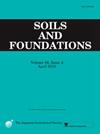Simulating field grouting to improve the shear strength of consolidated clay by microbially induced carbonate precipitation
IF 3.3
2区 工程技术
Q2 ENGINEERING, GEOLOGICAL
引用次数: 0
Abstract
Soft clay layers in urban areas pose challenges due to low strength and high compressibility, complicating urban construction. Microbially induced carbonate precipitation (MICP) has demonstrated its ability to enhance soil strength in sandy soils. However, research on the utilization of MICP for clay has been limited. Thus, this paper introduced a new method that combines MICP with grouting. The treated MICP solutions were injected into the consolidated clay samples in a triaxial system to simulate the improvement of grouting in the consolidated soil layer in the field. A series of modified triaxial tests, fluorescent nucleic acid stains, solution/soil pH tests, and microscopic observation tests were conducted. Results indicated a 1.7 times increase in soil strength with bioaugmentation treatment on clay under 150 kPa consolidation stress. Additionally, the weight of CaCO3 increased by 3.2 g, achieving a precipitation ratio of 58 %. The injected bacteria were observed in the bottom-most and center of the sample, confirming their mobility in the clay. The enhancement of shear strength on treated clay involved not only urease-producing bacteria but also environmental chemical reactions and natural bacterial effects. Furthermore, a microstructure changes of MICP in clay was observed, wherein CaCO3 effectively filled the pore spaces and bonded particles together to enhance strength. Based on the results, through MICP treatment with injection method, consolidated clay enhances its mechanical behavior and microstructural formation to improve the shear strength.
求助全文
约1分钟内获得全文
求助全文
来源期刊

Soils and Foundations
工程技术-地球科学综合
CiteScore
6.40
自引率
8.10%
发文量
99
审稿时长
5 months
期刊介绍:
Soils and Foundations is one of the leading journals in the field of soil mechanics and geotechnical engineering. It is the official journal of the Japanese Geotechnical Society (JGS)., The journal publishes a variety of original research paper, technical reports, technical notes, as well as the state-of-the-art reports upon invitation by the Editor, in the fields of soil and rock mechanics, geotechnical engineering, and environmental geotechnics. Since the publication of Volume 1, No.1 issue in June 1960, Soils and Foundations will celebrate the 60th anniversary in the year of 2020.
Soils and Foundations welcomes theoretical as well as practical work associated with the aforementioned field(s). Case studies that describe the original and interdisciplinary work applicable to geotechnical engineering are particularly encouraged. Discussions to each of the published articles are also welcomed in order to provide an avenue in which opinions of peers may be fed back or exchanged. In providing latest expertise on a specific topic, one issue out of six per year on average was allocated to include selected papers from the International Symposia which were held in Japan as well as overseas.
 求助内容:
求助内容: 应助结果提醒方式:
应助结果提醒方式:


